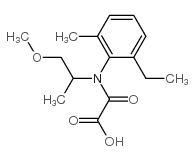Metolachlor OA Pestanal

Metolachlor OA Pestanal structure
|
Common Name | Metolachlor OA Pestanal | ||
|---|---|---|---|---|
| CAS Number | 152019-73-3 | Molecular Weight | 279.33200 | |
| Density | 1.158g/cm3 | Boiling Point | 411.4ºC at 760 mmHg | |
| Molecular Formula | C15H21NO4 | Melting Point | N/A | |
| MSDS | Chinese USA | Flash Point | 202.6ºC | |
|
The dual FAAH/MAGL inhibitor JZL195 has enhanced effects on endocannabinoid transmission and motor behavior in rats as compared to those of the MAGL inhibitor JZL184.
Pharmacol. Biochem. Behav. 124 , 153-9, (2014) The biological actions of the endocannabinoids anandamide and 2-arachidonoyl glycerol (2-AG) are terminated by enzymatic hydrolysis of these lipids via fatty acid amide hydrolase (FAAH) and monoacylglycerol lipase (MAGL), respectively. While several selective... |
|
|
Direct silylation of Trypanosoma brucei metabolites in aqueous samples and their GC-MS/MS analysis.
J. Chromatogr. B. Analyt. Technol. Biomed. Life Sci. 967 , 134-8, (2014) A simple two-step method for the derivatization of polar compounds (lactate, alanine, glycerol, succinate and glucose) using hexamethyldisilazane (HMDS) and N,O-bis(trimethylsilyl)trifluoroacetamide (BSTFA) was developed. This method allows direct derivatizat... |
|
|
Cardiovascular disease-related parameters and oxidative stress in SHROB rats, a model for metabolic syndrome.
PLoS ONE 9(8) , e104637, (2014) SHROB rats have been suggested as a model for metabolic syndrome (MetS) as a situation prior to the onset of CVD or type-2 diabetes, but information on descriptive biochemical parameters for this model is limited. Here, we extensively evaluate parameters rela... |
|
|
Free radical scavenging activity and comparative metabolic profiling of in vitro cultured and field grown Withania somnifera roots.
PLoS ONE 10(4) , e0123360, (2015) Free radical scavenging activity (FRSA), total phenolic content (TPC), and total flavonoid content (TFC) of in vitro cultured and field grown Withania somnifera (Ashwagandha) roots were investigated. Withanolides analysis and comprehensive metabolic profiling... |
|
|
Characterization of in vitro metabolites of JWH-018, JWH-073 and their 4-methyl derivatives, markers of the abuse of these synthetic cannabinoids
J. Chromatogr. B. Analyt. Technol. Biomed. Life Sci. 957 , 68-76, (2014) • Optimization of a suitable extraction protocol for alkylindoles and their metabolites from biological fluids. • Detection of alkylindoles and their metabolites by means of the GC/MS method adopted by UNODC. • In vitro incubation with human liver microsomes ... |
|
|
Multiresidue method for the determination of pharmacologically active substances in egg and honey using a continuous solid-phase extraction system and gas chromatography-mass spectrometry.
Food Chem. 178 , 63-9, (2015) A sensitive, selective, efficient gas chromatography-mass spectrometry method for the simultaneous determination of 22 pharmacologically active substances (antibacterials, nonsteroidal antiinflammatories, antiseptics, antiepileptics, lipid regulators, β-block... |
|
|
Effects of synthetic alkamides on Arabidopsis fatty acid amide hydrolase activity and plant development.
Phytochemistry 110 , 58-71, (2015) Alkamides and N-acylethanolamines (NAEs) are bioactive, amide-linked lipids that influence plant development. Alkamides are restricted to several families of higher plants and some fungi, whereas NAEs are widespread signaling molecules in both plants and anim... |
|
|
The terminal enzymes of cholesterol synthesis, DHCR24 and DHCR7, interact physically and functionally.
J. Lipid Res. 56(4) , 888-97, (2015) Cholesterol is essential to human health, and its levels are tightly regulated by a balance of synthesis, uptake, and efflux. Cholesterol synthesis requires the actions of more than twenty enzymes to reach the final product, through two alternate pathways. He... |
|
|
Occurrence, removal, and fate of progestogens, androgens, estrogens, and phenols in six sewage treatment plants around Dianchi Lake in China.
Environ. Sci. Pollut. Res. Int. 21(22) , 12898-908, (2014) The occurrence and behavior of endocrine disrupting chemicals (EDCs) in sewage treatment plants (STPs), especially estrogens and phenols, have been closely concerned in previous studies. However, the systematical researches about progestogens and androgens we... |
|
|
Sphingobium fuliginis HC3: a novel and robust isolated biphenyl- and polychlorinated biphenyls-degrading bacterium without dead-end intermediates accumulation.
PLoS ONE 10(4) , e0122740, (2015) Biphenyl and polychlorinated biphenyls (PCBs) are typical environmental pollutants. However, these pollutants are hard to be totally mineralized by environmental microorganisms. One reason for this is the accumulation of dead-end intermediates during biphenyl... |